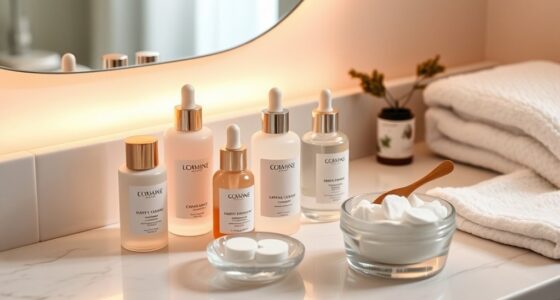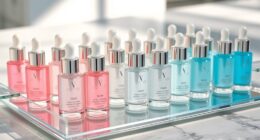When choosing clean beauty products, avoid ingredients like parabens, phthalates, formaldehyde, synthetic fragrances, mineral oils, sulfates, talc, and artificial dyes. These chemicals can disrupt hormones, cause skin irritation, and pose health or environmental risks. Look for labels indicating safer, natural alternatives and transparency on ingredients. By being mindful of these common offenders, you can create safer, more sustainable skincare routines. If you want to learn more, there’s plenty to discover about making smarter choices.
Key Takeaways
- Avoid parabens, synthetic fragrances, and phthalates due to hormonal disruption and allergenic risks.
- Choose products free from formaldehyde, its releasing agents, and harmful preservatives.
- Steer clear of mineral oils, petroleum derivatives, and sulfates that can irritate skin and clog pores.
- Be cautious of contaminated talc and synthetic dyes linked to health issues.
- Prioritize natural, plant-based ingredients and eco-friendly packaging for safer, sustainable beauty choices.
Parabens and Preservatives
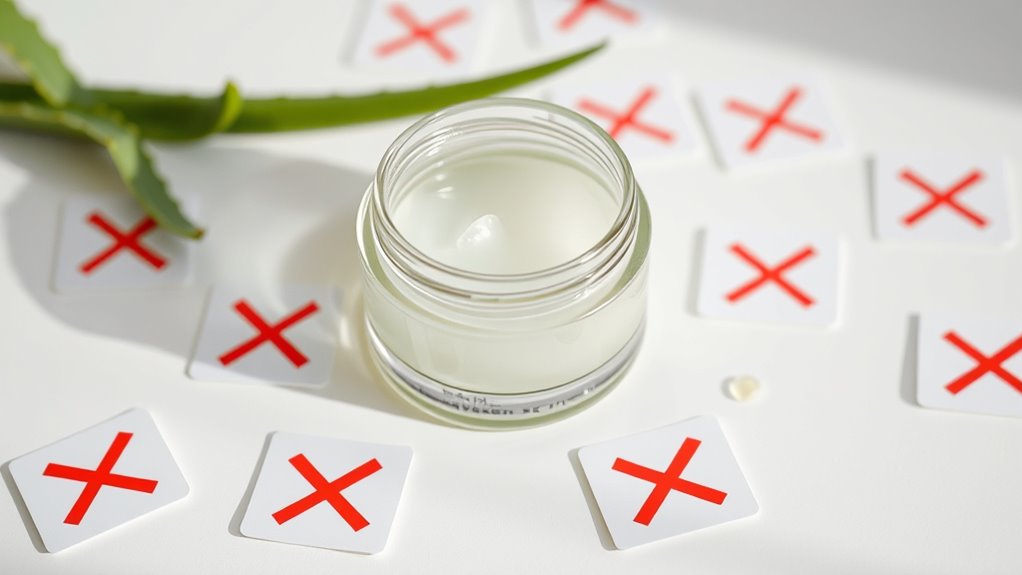
Have you ever wondered what’s really in your skincare products? Parabens and preservatives are common ingredients used to extend shelf life, but their safety is often questioned. When evaluating ingredient safety, it’s essential to weigh how regulatory standards govern their use. In many countries, authorities like the FDA or EU agencies set limits on paraben concentrations, but debates about potential health risks continue. Some studies suggest parabens may mimic hormones, raising concerns about hormonal disruption. As a consumer committed to clean beauty, you should scrutinize ingredient lists and choose products with safer preservative alternatives. Staying informed about regulatory standards helps you make better choices, ensuring your skincare routine aligns with your health and safety priorities. Also, understanding ethical hacking can help you protect your personal data from cyber threats online.
Phthalates and Plasticizers

Phthalates and plasticizers are hidden ingredients in many beauty products that can pose health risks. You’ll find them in items like fragrances, nail polishes, and packaging materials, often without realizing it. Luckily, there are safer alternatives you can choose to protect your health and the environment.
Health Risks of Phthalates
Because they are widely used as plasticizers in many personal care products, phthalates can easily enter your body through skin contact, inhalation, or ingestion. This exposure is especially concerning for babies, as phthalates in baby products can be absorbed through delicate skin. Once inside your body, phthalates can interfere with your endocrine system, leading to hormonal disruptions. Research links phthalates and endocrine disruption to reproductive issues, developmental problems, and increased risks of certain cancers. Young children and pregnant women are particularly vulnerable. Continuous exposure to phthalates increases the likelihood of these health risks, making it vital to choose products free from these chemicals. Avoiding phthalates helps protect your long-term health and supports safer, cleaner beauty choices. Additionally, understanding the regulatory challenges surrounding chemical safety can help consumers make more informed decisions.
Common Plasticizer Sources
Wondering where plasticizers like phthalates are commonly found? They often lurk in fragrances, hair sprays, and nail polishes to improve flexibility and durability. You’ll also find them in soft plastics, like packaging and tubing, which can transfer chemicals to products. Some cosmetics may contain phthalates even if not listed explicitly, due to ingredient complexity. To avoid these harmful plasticizers, look for products with ingredient transparency, so you know exactly what’s inside. Opt for plasticizer alternatives that are safer and free from phthalates. Being aware of common plasticizer sources helps you make informed choices, reducing exposure to potentially harmful chemicals. Understanding ingredient transparency is essential for making safer product choices. Always check labels carefully, and favor brands committed to clean, transparent ingredient lists.
Safer Ingredient Alternatives
To reduce exposure to harmful plasticizers, choosing products with safer ingredient alternatives is essential. Look for formulations that incorporate natural extracts, which often avoid synthetic plasticizers altogether. These natural options are gentle on your skin and better for the environment. Additionally, seek out brands that prioritize eco-friendly packaging, reducing plastic waste and exposure to harmful chemicals. Some effective alternatives include plant-based oils and mineral-based ingredients that provide similar benefits without the risks. By selecting products with these safer ingredients, you support cleaner beauty practices and minimize your health and environmental impact. Remember to read labels carefully and choose brands committed to transparency and sustainability. Making informed choices helps you enjoy effective, safer beauty products every day. Incorporating clean beauty standards can further guide you toward products that prioritize safety and sustainability.
Formaldehyde and Formaldehyde-Releasing Agents
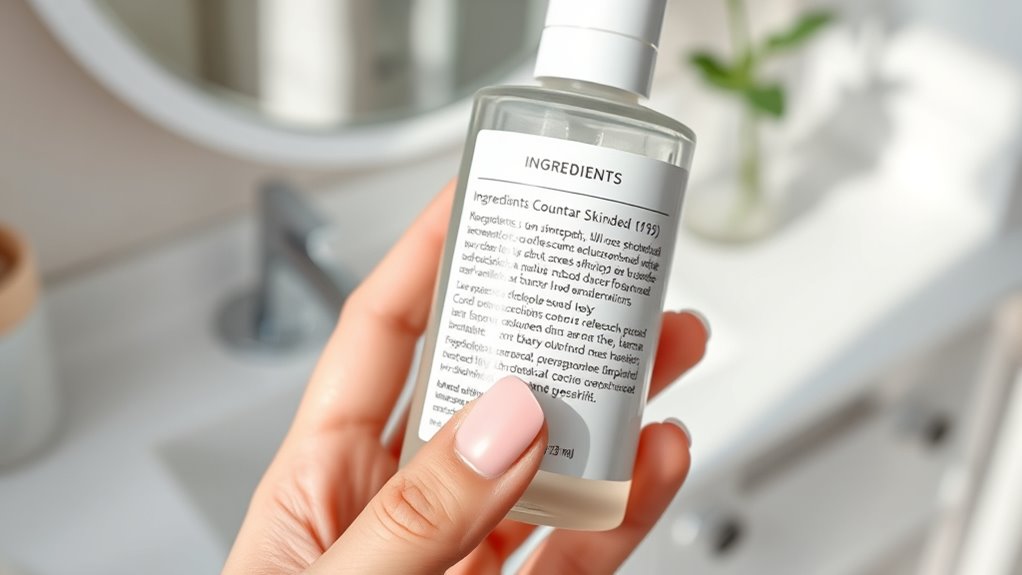
You might unknowingly expose yourself to formaldehyde through household products and cosmetics. This chemical can pose health risks like skin irritation and respiratory issues. Luckily, there are safer alternatives that help you avoid these harmful agents without sacrificing effectiveness. Being aware of cybersecurity vulnerabilities in product manufacturing and supply chains can also help you make more informed choices about the safety and integrity of the products you use.
Common Formaldehyde Sources
Formaldehyde and its releasers are common sources of formaldehyde in beauty products, often hidden in ingredient lists. You may not realize that exposure can happen through products like shampoos, nail polishes, and skincare. Because of cosmetic regulations, manufacturers sometimes list formaldehyde-releasing agents instead of free formaldehyde, making it harder to identify. To reduce formaldehyde exposure, look out for these ingredients:
- DMDM hydantoin
- Imidazolidinyl urea
- Quaternium-15
- Diazolidinyl urea
These are common formaldehyde-releasing agents used to preserve products. Staying informed helps you choose safer options and avoid unintentional exposure. Being aware of hidden sources is key to maintaining a clean beauty routine aligned with your health priorities. Additionally, cosmetic regulations influence how ingredients are listed, which can impact your ability to identify harmful preservatives.
Health Risks Explained
Exposure to formaldehyde and its releasers can pose significant health risks, even at low levels of contact. Formaldehyde is a known carcinogen, and prolonged exposure may increase your risk of certain cancers. Formaldehyde-releasing agents, often used in cosmetics for preservation, can cause skin irritation, allergies, and respiratory issues. While beauty industry regulations aim to limit safe levels, not all products are thoroughly tested or labeled clearly. That’s why consumer awareness campaigns are crucial—they empower you to recognize and avoid products containing these harmful ingredients. Staying informed helps you make safer choices and reduces your risk of adverse health effects. Always read labels carefully and seek out products certified free from formaldehyde and its releasers for a cleaner, healthier beauty routine.
Safer Alternatives Available
Are there safer options available to replace formaldehyde and its releasers in beauty products? Absolutely. Many brands now focus on natural skincare formulations that avoid harmful chemicals. You can also explore DIY beauty recipes using simple, non-toxic ingredients to customize your routine. These alternatives help reduce exposure to carcinogens while still delivering effective results. Look for products labeled as formaldehyde-free, or choose plant-based preservatives like potassium sorbate or sodium benzoate. Incorporate natural oils, herbal extracts, and essential oils in your skincare to keep it gentle and safe. Using safer ingredients not only benefits your health but also supports more sustainable and environmentally friendly beauty practices. By switching to these safer options, you protect your health and support cleaner beauty practices. Making informed choices doesn’t mean sacrificing quality—there are plenty of natural skincare solutions waiting to be discovered.
Synthetic Fragrances and Perfumes

Have you ever wondered what’s hidden behind the enticing scents in your favorite perfumes? Many synthetic fragrances use aroma masking or scent masking techniques to cover up unpleasant odors or create appealing fragrances. These fragrances often contain chemicals like phthalates, which can disrupt hormones and impact your health. Because they’re not required to be fully disclosed on labels, you may unknowingly expose yourself to potential allergens or harmful compounds. Synthetic fragrances are also linked to headaches, skin irritations, and respiratory issues. Choosing products labeled “fragrance-free” or those with natural essential oils helps you avoid these risks. By steering clear of synthetic perfumes, you support a cleaner beauty routine that minimizes exposure to hidden chemicals and promotes better overall health. Understanding ingredient transparency can help you make more informed choices about the products you use.
Mineral Oil and Petroleum-Based Ingredients
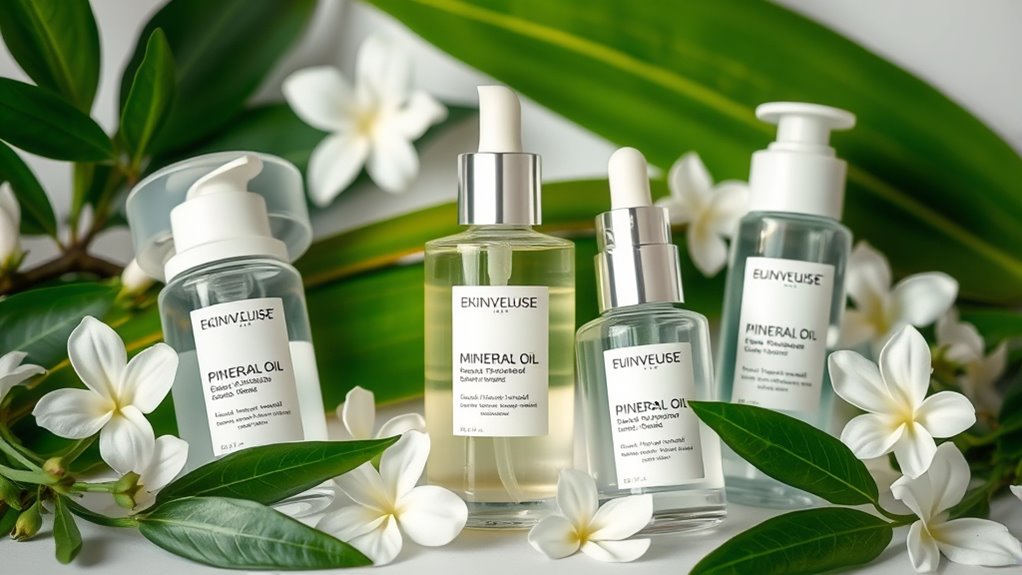
Mineral oil and other petroleum-based ingredients are common in many skincare and beauty products, but they can pose health concerns. These ingredients are derived from non-renewable resources and may clog pores or cause breakouts. Additionally, some studies suggest they can trap dirt and bacteria, leading to skin irritation. You should be cautious when choosing products containing mineral oil and petroleum-based ingredients. Scientific skepticism also questions the predictive power of astrology, emphasizing the importance of relying on evidence-based information when selecting skincare ingredients. Consider avoiding these ingredients if you want to minimize exposure to potential toxins. Look for alternatives that use natural oils and plant-based moisturizers. Reading labels carefully can help you identify and steer clear of products with unnecessary petroleum derivatives.
- Block pores and cause breakouts
- Trap dirt and bacteria
- Derived from non-renewable resources
- May cause skin irritation
Sodium Lauryl Sulfate and Sulfates
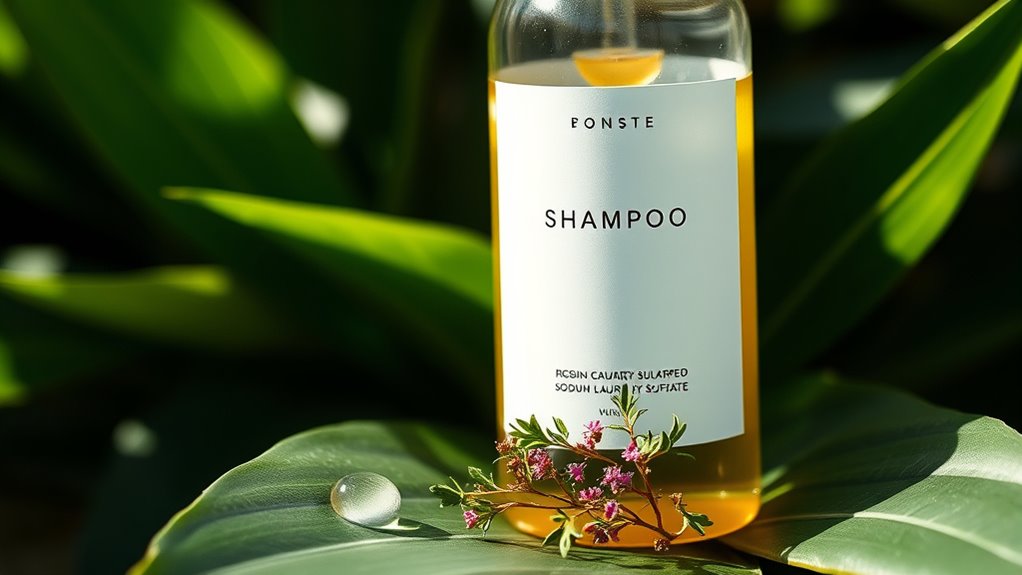
Wondering about the ingredients in your shampoo and body wash? Sulfates, like Sodium Lauryl Sulfate, are common surfactants used as cleansing agents. They create foam and effectively remove dirt and oil, but they can also strip your skin and hair of natural oils, leading to dryness and irritation. Sulfates are harsh surfactants often found in many personal care products, especially those that aim for a foaming effect. While they’re effective cleansers, many people prefer to avoid them due to their potential to cause sensitivity and disrupt the skin’s barrier. Opting for sulfate-free products means choosing gentler cleansing agents that clean without stripping moisture. Always check ingredient labels if you’re aiming for cleaner, more nourishing beauty options.
Talc and Potential Contaminants

While sulfate-free products help protect your skin and hair from harsh chemicals, another ingredient to watch out for is talc. Talc contamination can pose risks because it may contain asbestos or other harmful contaminants, raising concerns about cosmetic safety. You should be cautious when choosing talc-based products, especially in powders and blushes. Always check labels for third-party testing or certifications that verify safety. Keep these points in mind:
Talc may contain asbestos; always check for third-party safety testing before use.
- Talc contamination can include asbestos, a known carcinogen
- Not all talc is tested for cosmetic safety
- Mineral-based alternatives are safer options
- Always research brands committed to clean beauty standards
- Proper storage and handling of cosmetic powders can help reduce the risk of contamination or exposure
Being aware of talc and its potential contaminants helps you make informed choices and avoid unnecessary health risks.
Certain Colorants and Dyes
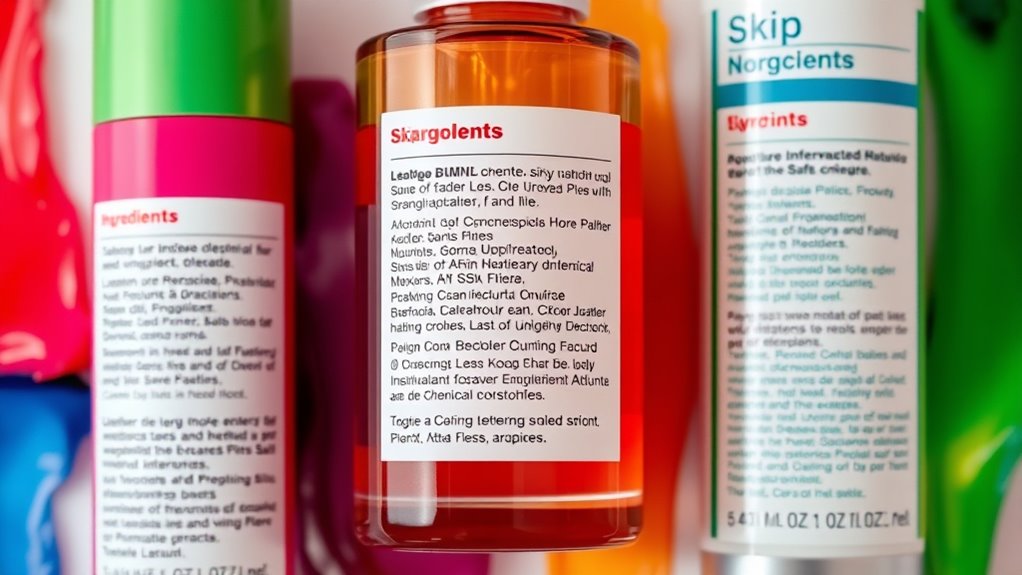
Have you ever considered what’s really in the colorful products you use every day? Many cosmetics contain certain colorants and dyes that may pose health risks. Not all colorant safety is equal, as some synthetic dyes can contain contaminants or allergens. It’s essential to look for dye transparency on ingredient labels, so you know exactly what’s in your products. Artificial dyes like FD&C and D&C colors are common but may contain impurities linked to allergic reactions or sensitivities. Natural alternatives are preferable, but they also require transparency to ensure they’re free from harmful additives. By choosing products with clear, honest ingredient lists and avoiding questionable dyes, you support a cleaner beauty routine that’s safer for your skin and overall health.
Frequently Asked Questions
Are Natural Ingredients Always Safer Than Synthetic Ones?
You might think natural ingredients are always safer than synthetic ones, but natural misconceptions can be misleading. Not all natural substances are safe, and some can cause allergies or irritation. Conversely, synthetic ingredients are often rigorously tested for safety. So, don’t assume natural equals safer; instead, check ingredient safety data. Your best bet is to research and choose products based on proven safety, regardless of whether ingredients are natural or synthetic.
How Can I Identify Hidden Harmful Ingredients on Labels?
When you’re checking labels, watch out for chemical masking and confusing ingredient jargon. Manufacturers often use tricky names to hide harmful chemicals, so don’t just rely on familiar terms. Instead, research unfamiliar ingredients online or use apps designed to identify potentially harmful substances. Read the labels carefully, and if you see complicated chemical names, take a moment to verify their safety—your skin and health are worth the extra effort.
Do Organic Certifications Guarantee a Product Is Non-Toxic?
When it comes to organic certifications, don’t assume they’re the be-all and end-all. While organic labels and certification standards aim to ensure safety, they don’t guarantee a product is non-toxic. Think of it as the proof of the pudding—always read the ingredients list and research the certifying body. Certifications are helpful, but ultimately, being informed about ingredients is your best bet for choosing truly safe, non-toxic products.
Can Clean Beauty Products Still Cause Allergic Reactions?
Yes, clean beauty products can still cause allergic reactions, especially if you have fragrance sensitivities or preservative reactions. Even natural ingredients or those marketed as gentle may trigger allergies in some people. Always patch-test new products and check ingredient lists carefully. Just because a product is labeled clean doesn’t guarantee it’s free from allergens. Stay informed and listen to your skin’s responses to avoid unwanted reactions.
What Are the Best Resources for Researching Ingredient Safety?
Imagine browsing a well-organized library of ingredient databases, where every label tells a story of safety. You can explore trusted sources like the Environmental Working Group’s Skin Deep database or the EWG’s Guide to Safe Ingredients. Safety guidelines from organizations like the FDA also illuminate your path. These resources help you make informed choices, ensuring your beauty routine is both beautiful and safe.
Conclusion
Now that you know which ingredients to avoid, your journey toward clean beauty becomes clearer. But remember, the world of ingredients is vast and constantly evolving. Will you uncover hidden toxins lurking in your favorite products? Stay vigilant, stay curious. The path to truly safe, natural beauty is full of surprises—are you ready to dig deeper and make informed choices that could change everything? The next step might just surprise you.





